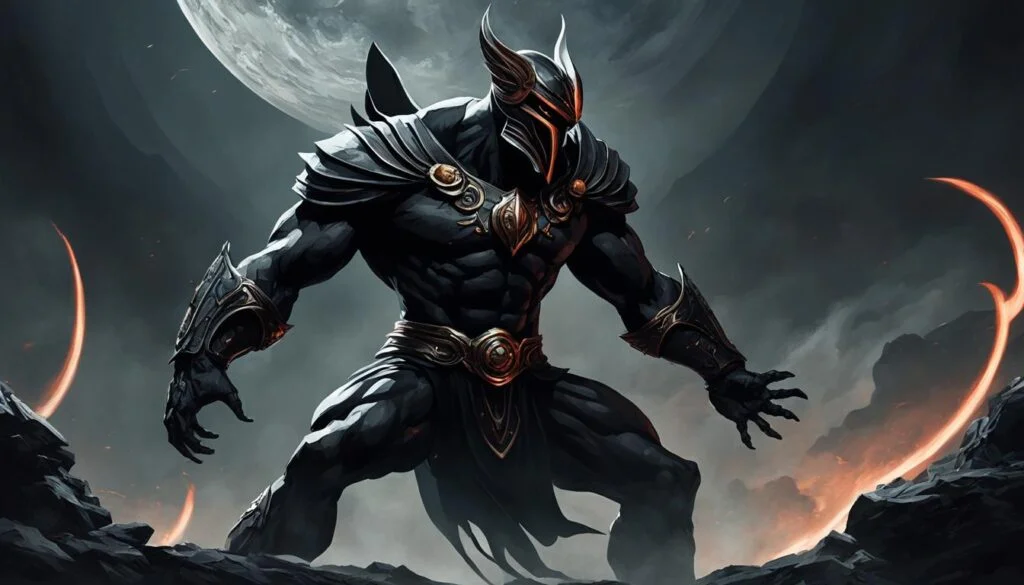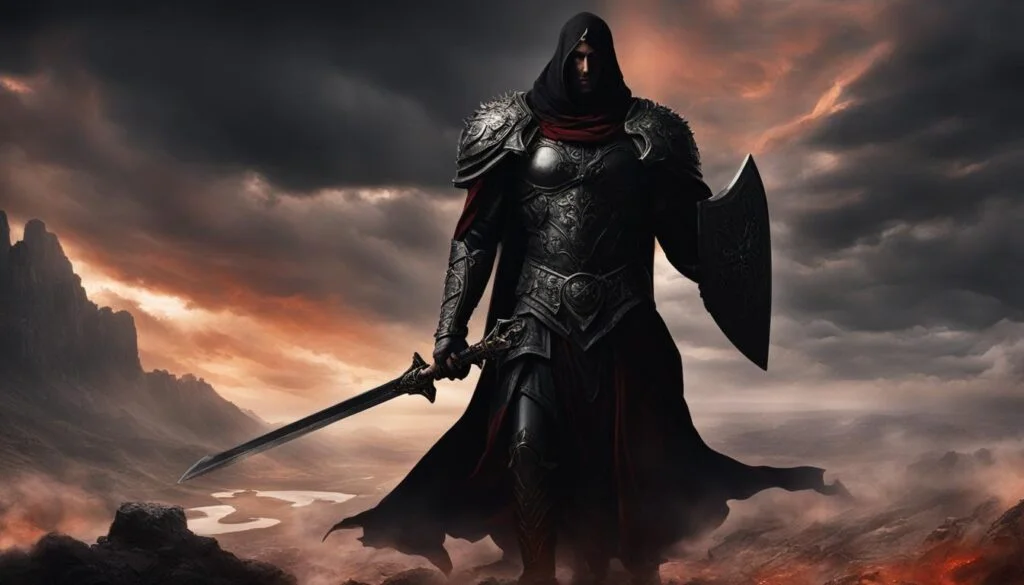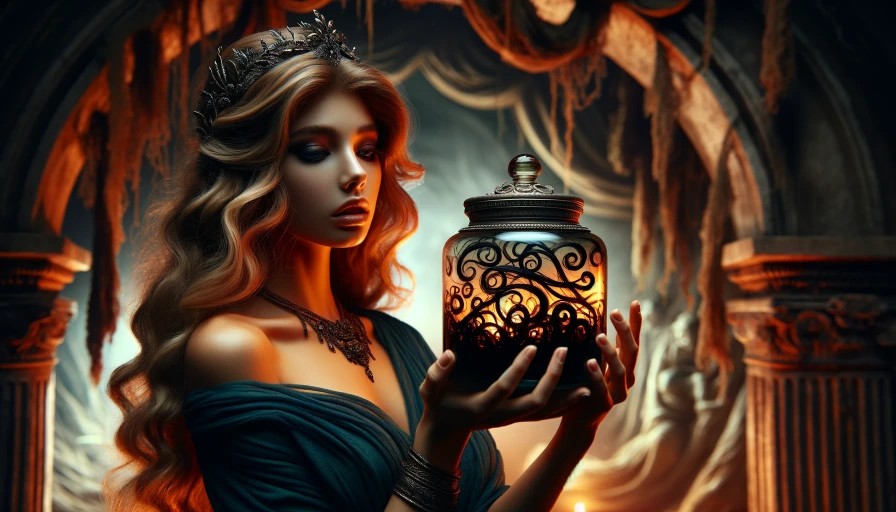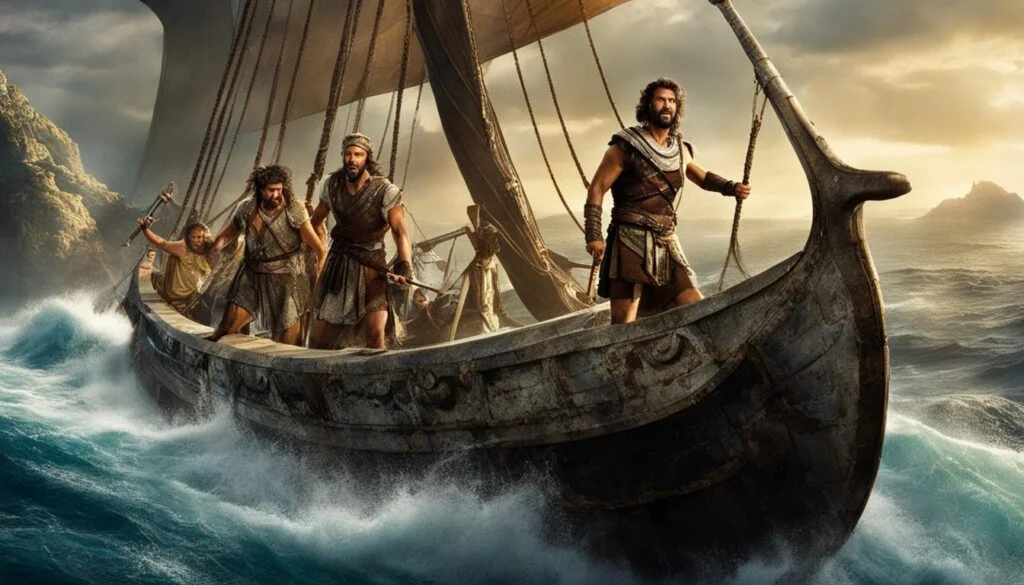In Greek mythology, Deimos is the personification of terror. As the son of Ares and Aphrodite, he symbolizes fear and dread, particularly in battles. Alongside his brother Phobos, Deimos spreads terror and instills a sense of panic in armies.
Deimos is mentioned in various ancient Greek stories and plays a significant role in portraying the horrifying aspects of warfare. In Hesiod’s Theogony, he is even identified as the father of the fearsome monster Scylla.
In art, Deimos is often depicted as a young man or with leonine features. He has also left his mark in astronomy, with one of the moons of Mars named after him.
Key Takeaways:
- Deimos is the personification of terror in Greek mythology.
- He is the son of Ares and Aphrodite.
- Deimos spreads fear and panic in battles.
- He is mentioned in ancient Greek stories, including Hesiod’s Theogony.
- Deimos is often depicted in art as a young man or with leonine features.
The Genealogy of Deimos
According to Hesiod’s Theogony, Deimos is the son of Ares and Aphrodite. He has a brother named Phobos and a sister named Harmonia. Deimos is born from the union of the god of war and the goddess of love, representing the feelings of terror and dread that accompany conflict and warfare. This genealogy highlights the connection between fear and war in Greek mythology.
The Mythology of Deimos
Although Deimos is not prominently featured in mythological narratives, he plays a significant role as a personification of terror in battles. In Homer’s Iliad, Deimos is mentioned as accompanying his father Ares into battle against the goddess of discord, Eris. He is also mentioned in the Shield of Heracles, where he and his brother Phobos assist Ares during his fight with Herakles. In Nonnus’ Dionysiaca, Zeus arms Phobos with lightning and Deimos with thunder to frighten the monster Typhon. These references highlight the association of Deimos with warfare and the terrifying aspects of combat.
Deimos in Art and Literature

Deimos, the personification of terror, has been a recurring figure in art and literature throughout history. Artists and writers have sought to capture the essence of fear and dread associated with Deimos, showcasing his presence in different mediums and contexts.
In Greek art, Deimos is often portrayed as an ordinary youth or occasionally with leonine features. These representations highlight his role in evoking terror and instilling fear in the hearts of men. One notable depiction of Deimos can be found on Achilles’ legendary shield in Homer’s epic poem, the Iliad. On the shield, Deimos is described as terrifying, symbolizing the psychological impact of fear on the battlefield.
Deimos also makes an appearance in Roman mythology, where he is known as Metus or Formido. In Roman culture, Deimos further emphasizes his position as the embodiment of fear and terror. This recognition across different mythological traditions showcases the enduring significance and impact of Deimos as a symbol of dread and trepidation.
Interestingly, the influence of Deimos extends beyond mythology into astronomy. One of the moons orbiting Mars is named Deimos, immortalizing the Greek god’s legacy in celestial bodies. This celestial connection further highlights the profound role Deimos plays not only in ancient myths but also in our understanding of the universe.
Throughout history, Deimos’ representation in art and literature has contributed to our understanding of fear and the human experience. His portrayal as the personification of terror serves as a reminder of the intense emotions and consequences associated with conflict and warfare. By exploring Deimos’ artistic and literary portrayals, we gain a deeper appreciation for the transformative power of fear and its impact on individuals and societies.
The Symbolism of Deimos

In Greek mythology, Deimos personifies dread and terror, particularly in the context of warfare. He embodies the fear that engulfs soldiers before and during battles, evoking a sense of dread and panic. The symbolism of Deimos lies in his association with the negative emotions and consequences of conflict, which highlights the devastating impact of war on both individuals and societies.
Deimos serves as a haunting reminder of the terrifying aspects of human experience and the destructive power of fear. In the chaos of warfare, the presence of Deimos instills a deep sense of dread, amplifying the already overwhelming emotions on the battlefield. He represents the psychological and emotional trauma that accompanies armed conflicts, emphasizing the lasting scars left by war.
Whether in ancient Greek stories or modern interpretations of his symbolism, Deimos stands as a powerful symbol of the horrors of war and the heavy toll it takes on humanity. His name echoes through the annals of history as a testament to the profound impact fear has on warfare, forever reminding us of the darkness that can consume both individuals and societies.
Conclusion
Deimos, the personification of terror in Greek mythology, holds a significant place in ancient stories and artistic representations. As the son of Ares and Aphrodite, he embodies the feelings of dread and terror associated with warfare. Although not extensively featured in mythological narratives, Deimos plays a crucial role in highlighting the terrifying aspects of battle and the destructive power of fear.
His representation in art and the naming of one of Mars’ moons after him further emphasizes his importance in Greek mythology. The enigma of Deimos in Greek mythology continues to captivate and intrigue, making him a figure of enduring interest and significance.
FAQ
Who is Deimos in Greek mythology?
Deimos is the personification of terror in Greek mythology. He is the son of Ares and Aphrodite and is often depicted as a young man or with leonine features.
What is the genealogy of Deimos?
Deimos is the son of Ares and Aphrodite. He has a brother named Phobos and a sister named Harmonia.
What is Deimos’ role in mythology?
Deimos plays a significant role as a personification of terror in battles. He is mentioned in various mythological narratives such as Homer’s Iliad and the Shield of Heracles.
How is Deimos depicted in art and literature?
Deimos is often depicted as a young man or with leonine features. He can be seen on Achilles’ shield in Homer’s Iliad and is also known as Metus or Formido in Roman mythology.
What is the symbolism of Deimos?
Deimos symbolizes dread and terror, particularly in relation to warfare. He represents the fear that soldiers experience before and during battles, highlighting the destructive power of fear.




